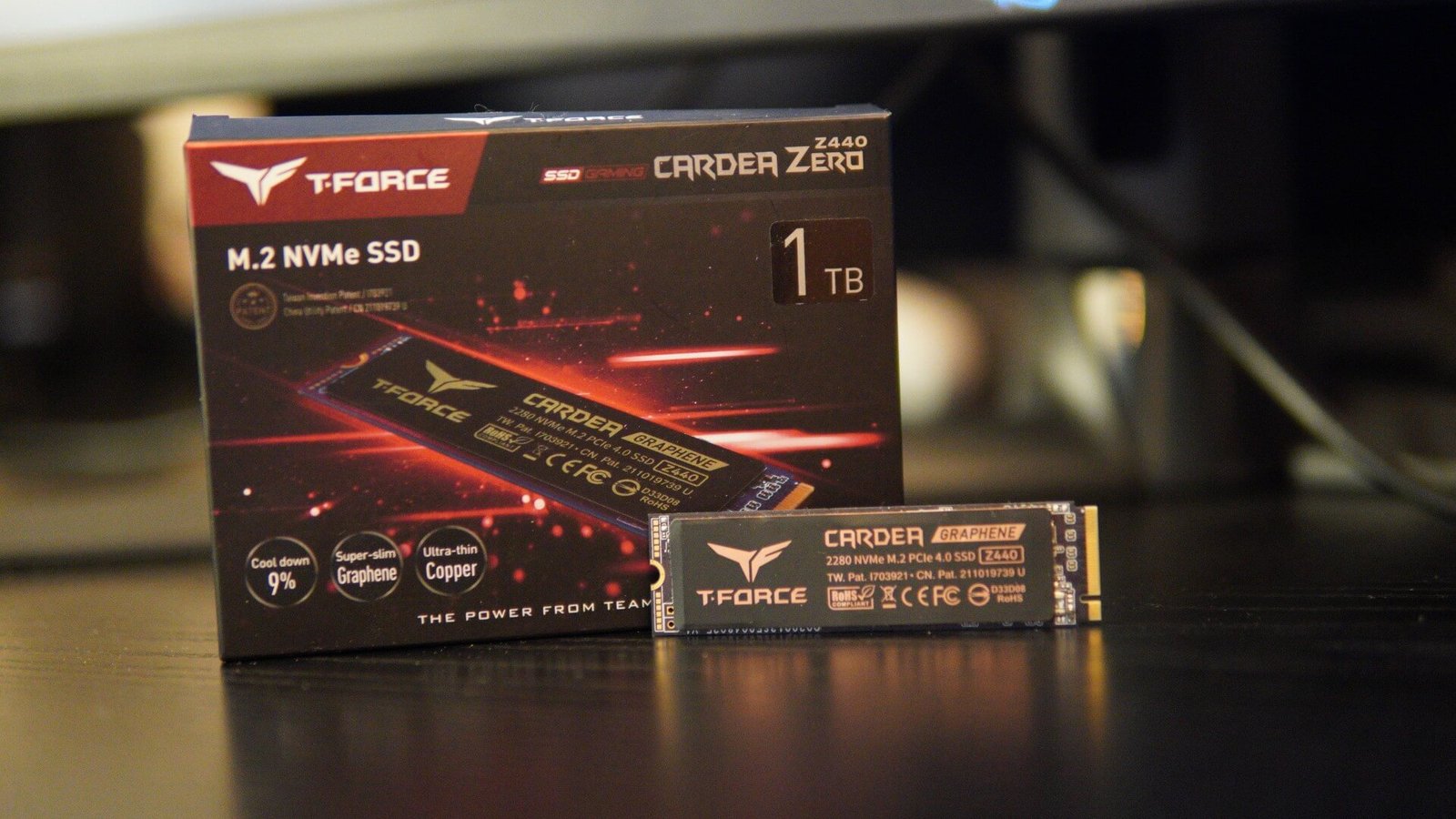The popularity and demand for PCIe 4.0 SSDs have increased among casual users, PC gamers, console owners, and creative professionals for their speed and performance. We got a chance to try out the 1TB Cardea Zero Z440 PCIe 4.0 SSD and here are our thoughts about the drive.
The Cardea Zero Z440 that we got for review came with the latest black-coated PCB as compared to the usual blue-colored PCB models. The drive weighs only 9g and our 1TB evaluation sample features memory chips on both sides of the drive. The physical dimensions of the drive are 80.0(L) x 22.0(W) x 3.7(H) mm.
While PCIe 4.0 SSDs come with thick heatsinks, Teamgroup has used its ultra-thin graphene heat spreader and this helps to maintain the drive’s temperatures lower and reduce throttling. This is especially useful for gamers who are looking to upgrade their laptops. The company suggests that the graphene heat spreader is capable of providing up to 9% lower temperatures while the drive goes through heavy read and write operations for three hours. 
While the top side of the Z440 comes with the heat spreader, the bottom area is covered with the normal Teamgroup SSD sticker. There is also a 2TB model of the Z440 for those looking for more storage. With respect to voltage, the drive can consume around +3.3V. For those who will be using the drive for heavy intensive tasks, the 1TB Z440 features a respective endurance of 1800TBW, along with the 2TB that comes with an endurance of 3600TBW.
Along with its PCIe 4.0 interface, NVMe 1.3 specifications, and the help of its DRAM cache, the Z440 is capable of reaching read speeds up to 5000 MB/s and write speeds up to 4400MB/s. The IOPS read/write speeds can reach up to 750,000.
 We tested the Teamgroup Zero Z440 on our testbed that comes with the ASUS X570 TUF Gaming motherboard, the AMD Ryzen 7 3800XT processor, 16GB of Teamgroup Delta RGB DDR4 3600Mhz memory, a 1TB Kingston KC600 SATA drive, 1000W XFX PSU and the XFX Radeon RX 5700 XT GPU. We used benchmark tools such as CrystalDiskMark, AS SSD, 3D Mark Storage, PCMark storage, and DiskSpeed Test.
We tested the Teamgroup Zero Z440 on our testbed that comes with the ASUS X570 TUF Gaming motherboard, the AMD Ryzen 7 3800XT processor, 16GB of Teamgroup Delta RGB DDR4 3600Mhz memory, a 1TB Kingston KC600 SATA drive, 1000W XFX PSU and the XFX Radeon RX 5700 XT GPU. We used benchmark tools such as CrystalDiskMark, AS SSD, 3D Mark Storage, PCMark storage, and DiskSpeed Test.
 From the tests that we have performed, the Z440 scored around 5009MB/s read speeds and 4029MB/s write speeds for SEQ1M Q8T1. For AS SSD, we got a score of 4221MB/s and 3712MB/s read and write speeds, respectively. For those using the DiskSpeed application, the drive achieved 4100MB/s read speeds and 3779MB/s write speeds. We also got benchmark scores of 2892 for the 3DMark gaming storage test and 1554 for the PCMark Storage test.
From the tests that we have performed, the Z440 scored around 5009MB/s read speeds and 4029MB/s write speeds for SEQ1M Q8T1. For AS SSD, we got a score of 4221MB/s and 3712MB/s read and write speeds, respectively. For those using the DiskSpeed application, the drive achieved 4100MB/s read speeds and 3779MB/s write speeds. We also got benchmark scores of 2892 for the 3DMark gaming storage test and 1554 for the PCMark Storage test.
- CrystalDiskMark
- AS SSD
- 3DMark Storage
- PCMark Storage
- BlackMagic Speed Test
We also performed a manual folder transfer copy test, where 100GB of the GTA V game folder is copied within the drive. The average transfer speed achieved is 487MB/s and the transfer took about 3 minutes and 49 seconds.

We also tried the SSD on the Sony PlayStation 5 and installing it was easy on the console’s M.2 drive slot.
 While 5500 MB/s is the minimum recommended read speed, the Z440 was capable of achieving a read speed of 3891MB/s read speeds and the PS5 was still able to accept the drive as secondary M.2 storage.
While 5500 MB/s is the minimum recommended read speed, the Z440 was capable of achieving a read speed of 3891MB/s read speeds and the PS5 was still able to accept the drive as secondary M.2 storage.
For those looking for a decent and affordable PCIe 4.0 SSD, the Teamgroup Cardea Zero Z440 PCIe 4.0 SSD is a good choice to consider. The drive features Teamgroup’s ultra-thin graphene heat spreader to help keep the temperatures lower and weighs hardly 9g. The drive is available in 1TB and 2TB capacities.
 Along with its PCIe 4.0 interface, the Cardea Zero Z440 sports a DRAM cache and is capable of reaching read speeds of 5000 MB/s and write speeds up to 4400MB/s, along with IOPS speeds topping up to 750,000. Despite the lower speeds, the Z440 works well with the PlayStation 5 console. The drive is suited for professionals, content creators, gamers and casual users.
Along with its PCIe 4.0 interface, the Cardea Zero Z440 sports a DRAM cache and is capable of reaching read speeds of 5000 MB/s and write speeds up to 4400MB/s, along with IOPS speeds topping up to 750,000. Despite the lower speeds, the Z440 works well with the PlayStation 5 console. The drive is suited for professionals, content creators, gamers and casual users.









